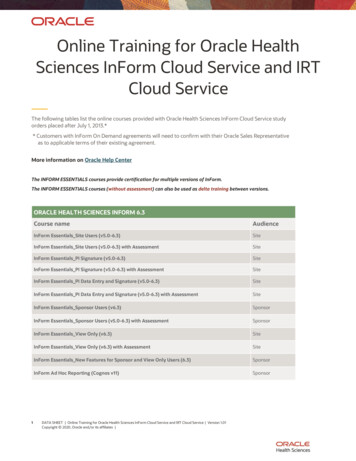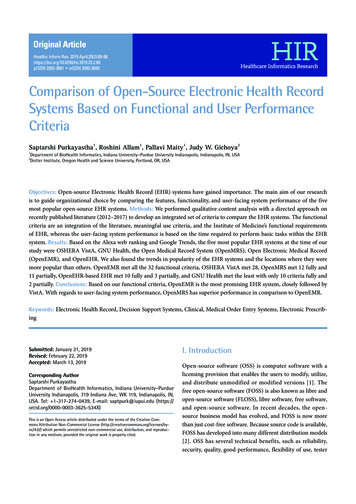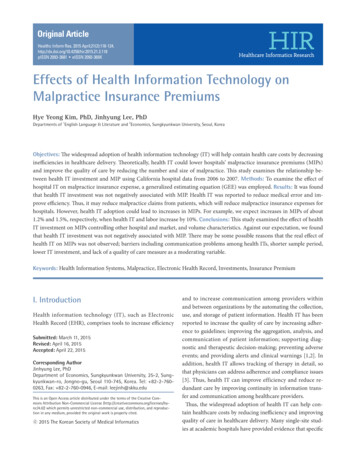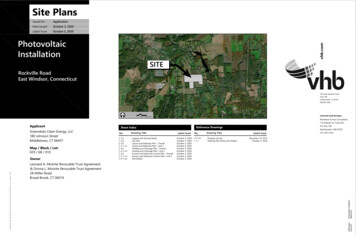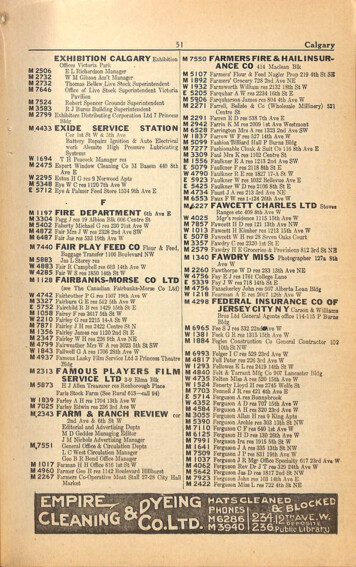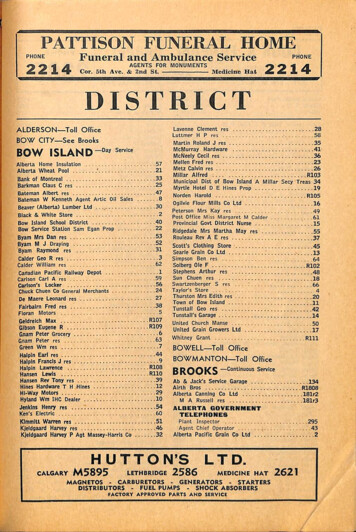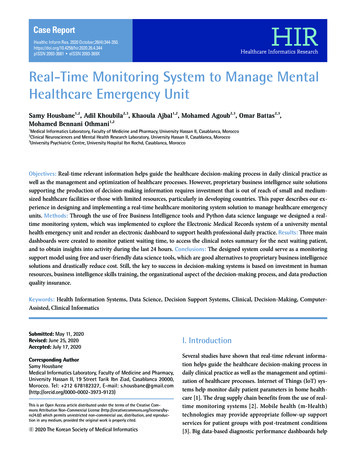
Transcription
Case ReportHealthc Inform Res. 2020 2020.26.4.344pISSN 2093-3681 eISSN 2093-369XReal-Time Monitoring System to Manage MentalHealthcare Emergency UnitSamy Housbane1,2, Adil Khoubila2,3, Khaoula Ajbal1,2, Mohamed Agoub2,3, Omar Battas2,3,Mohamed Bennani Othmani1,21Medical Informatics Laboratory, Faculty of Medicine and Pharmacy, University Hassan II, Casablanca, MoroccoClinical Neurosciences and Mental Health Research Laboratory, University Hassan II, Casablanca, Morocco3University Psychiatric Centre, University Hospital Ibn Rochd, Casablanca, Morocco2Objectives: Real-time relevant information helps guide the healthcare decision-making process in daily clinical practice aswell as the management and optimization of healthcare processes. However, proprietary business intelligence suite solutionssupporting the production of decision-making information requires investment that is out of reach of small and mediumsized healthcare facilities or those with limited resources, particularly in developing countries. This paper describes our experience in designing and implementing a real-time healthcare monitoring system solution to manage healthcare emergencyunits. Methods: Through the use of free Business Intelligence tools and Python data science language we designed a realtime monitoring system, which was implemented to explore the Electronic Medical Records system of a university mentalhealth emergency unit and render an electronic dashboard to support health professional daily practice. Results: Three maindashboards were created to monitor patient waiting time, to access the clinical notes summary for the next waiting patient,and to obtain insights into activity during the last 24 hours. Conclusions: The designed system could serve as a monitoringsupport model using free and user-friendly data science tools, which are good alternatives to proprietary business intelligencesolutions and drastically reduce cost. Still, the key to success in decision-making systems is based on investment in humanresources, business intelligence skills training, the organizational aspect of the decision-making process, and data productionquality insurance.Keywords: Health Information Systems, Data Science, Decision Support Systems, Clinical, Decision-Making, ComputerAssisted, Clinical InformaticsSubmitted: May 11, 2020Revised: June 25, 2020Accepted: July 17, 2020Corresponding AuthorSamy HousbaneMedical Informatics Laboratory, Faculty of Medicine and Pharmacy,University Hassan II, 19 Street Tarik Ibn Ziad, Casablanca 20000,Morocco. Tel: 212 678182327, E-mail: 73-9123)This is an Open Access article distributed under the terms of the Creative Commons Attribution Non-Commercial License (http://creativecommons.org/licenses/bync/4.0/) which permits unrestricted non-commercial use, distribution, and reproduction in any medium, provided the original work is properly cited. 2020 The Korean Society of Medical InformaticsI. IntroductionSeveral studies have shown that real-time relevant information helps guide the healthcare decision-making process indaily clinical practice as well as the management and optimization of healthcare processes. Internet of Things (IoT) systems help monitor daily patient parameters in home healthcare [1]. The drug supply chain benefits from the use of realtime monitoring systems [2]. Mobile health (m-Health)technologies may provide appropriate follow-up supportservices for patient groups with post-treatment conditions[3]. Big data-based diagnostic performance dashboards help
Real-Time Healthcare Monitoring Systemto operationally monitor diagnostic quality and safety [4].Electronic dashboards support evidence-based decisionmaking to overcome hospital capacity inefficiencies [5].However, obtaining real-time decision-making informationfrom clinical data is not straightforward. For a healthcarefacility to become data-driven, both organizational and technical decision-making process aspects must be addressed[6]. The organizational part of the decision-making processinvolves adopting a business decision-making strategy, notably defining strategic objectives and their correspondent keyperformance indicators [7]. The technical part of this process involves investing in technical infrastructure, businessintelligence solutions, and staff training.Activity-centered information system solutions intendedfor Electronic Health Records systems, laboratory information systems, radiology information systems, or pharmacyinformation systems offer perimeter-restricted and specificfunctionalities dashboards and only partially fulfill facilitydecisional needs, which also require investment in businessintelligence solutions [8]. Indeed, business analytics techniques have been recently used to address these decisionalneeds [9].Studies of personal developed solutions or proprietarybased real-time dashboards as business intelligence solutionsto monitor healthcare activities have been recently published[5,10]. Nevertheless, recent data science tools, such as Python and Jupyter offer a free, time-saving learning curve anduser-friendly data exploring and data visualization toolkits,which could assist a large community of users in managingtheir own healthcare facilities.This paper describes our experience in designing andimplementing a real-time healthcare monitoring system solution through the use of data science tools.ing system was needed.2. Real-Time Monitoring System Design1) System designThe system was designed to respond to three questions: howmany patients are waiting, who is the next patient, and howwere patients distributed during the previous day. It was developed as a minimal-content and simplified wall-mounteddashboard. Thus, three dashboards were designed: a wallmounted wait-time dashboard, a clinical summary dashboard, and a 24-hour managerial dashboard.When physically received in the emergency room (ER), apatient is identified in the EMR system and his or her data isprocessed in real time to be retrieved in the ER dashboard.The main computed key metrics are waiting time in minutes, sociodemographic factors (age, sex), recorded clinicalnotes summary (established diagnosis, if one exists; historyof suicidal behavior or aggression; prior hospitalization andconsultation count and dates; last prescribed drugs).Technically, we set up three physical servers running thefree Linux distribution Ubuntu server. Figure 1 shows thedesign of the implemented real-time monitoring system.2) Data processingThe Extract Transform Load (ETL) server runs automatedETL transformations to query EMR data, to compute keymetrics, and to store results in the data warehouse (DHW)server as illustrated in Figure 2. To manage ETL transformation, we installed the free community Pentaho Data integration (Kettle). Using the graphical user interface (GUI) ofKettle, information technology (IT) users periodically manage ETL transformations. To manage DWH databases weinstalled the free database management system MySQL andits free management web client phpMyAdmin.II. Case Description1. Project SettingsThe psychiatric emergency unit of the University PsychiatricCenter in Casablanca is the reference unit in the westernregion of Morocco for urgent and serious psychiatric disorders of patients with suicidal behavior or aggression risk. Itreceives 30 to 40 patients daily. The initial management of apatient must be efficient to establish a rapid assessment withminimum patient–caregiver contact. Implementation of anElectronic Medical Record (EMR) system since November2018 has improved access to patient records, but to providereal-time monitoring of received patients and obtain quickaccess to their clinical notes summary, a real-time monitor-Vol. 26 No. 4 October 2020EMRETLDWHUserHPITITConsoleWebbrowserOpen owserbrowser browserPentaho DI MySQL client Python Pythonphpmyadmin JupyterKettleVoilaEMR: electronic medical records serverETL: extract transform load serverDWH: data warehouse serverDSS: decision support system serverHP: health professional userIT: information technology user: real time data processing: periodic data processingFigure 1. Emergency real-time monitoring system design. Healthprofessionals are data producers and consumers, and ITusers periodically manage data processes.www.e-hir.org345
Samy Housbane et alFigure 2. Pentaho Kettle Extract Trans formation Load (ETL) tool toretrieve emergency EMR dataand to store it in the datawarehouse databases.Figure 3. Jupyter Notebook to createand manage ER dashboard.3) Data visualizationWe set up a decision support system (DSS) server runningthe data science programming language Python and its packages to manage and visualize dashboards. We used Jupyterto create and run Python command lines within web pagescalled notebooks as shown in Figure 3. A Jupyter notebookis a user-friendly high-level web development environmentwhere we import Python packages and run Python scriptsfor various tasks, such as data visualization or statistical operations. To create dashboard graphics, we used the PythonPlotly [11] package. The Python package Sqlalchemy (https://www.sqlalchemy.org) is used to connect to the data warehouse database and to query data with the structured querylanguage (SQL) from within a Jupyter notebook. IPython(https://ipython.org) display and Ipython html are used to346www.e-hir.orgrender html text and webpages within a dashboard.Dashboards created within a Jupyter notebook are sharedas code-free web pages through another Python package,Voila [12], which allows healthcare professionals to visualizeand interact with dashboards using only web browsers. Figure 4 shows the ER waiting time dashboard.4) Real-time processingTo ensure real-time data processing, we configured anUbuntu server cron job file to run automatically implemented ETL transformations and notebooks every 5 minutes asshown in Figure 5.https://doi.org/10.4258/hir.2020.26.4.344
Real-Time Healthcare Monitoring SystemFigure 4. E mergency waiting timedashboard webpage rendered with Voila.Figure 5. Ubuntu Cron job file confi gu ration to run automa ti c ally implemented ETLtrans formation and notebooks.3. Results1) Real-time emergency waiting time monitoringThe ER waiting time dashboard shown in Figure 6 visualizesthe next patient information, namely, the patient’s identifier,waiting time, and relative difference in waiting time compared to the waiting time annual median. Colored thresholdsrepresent the waiting time annual median, the 3rd quartile,and 80th percentile. The next waiting patients are represented on a table according to arrival date and waiting time.Vol. 26 No. 4 October 20202) Next patient on demand clinical notes summaryBy clicking on the next patient’s identifier on the ER waitingtime dashboard, the caregiver directly accesses a summary ofsupportive key clinical notes, allowing the caregiver to havean idea of the patient’s history as shown in Figure 7.3) Last 24-hour ER activity monitoringER staff have access through the ER last 24-hour dashboardto key managerial information on patient count, characteristics, waiting time distribution, and administered psychiatricwww.e-hir.org347
Samy Housbane et aldrugs as shown in Figure 8.4) Implementation statisticsSince implementation on April 6, 2020, 2,018 cases wereprocessed corresponding to 1,482 patients. The waiting timedashboard was trigged 1,569 times by health professionals toobtain insights into patient history through the clinical notessummary dashboard.III. Discussionprofessionals perceives the system positively and is convinced of its positive contribution to manage the activity ofpsychiatric emergencies, especially in the fall period whenthere is a significant flow of patients into the ER. They concluded that this real-time monitoring system impacts patients’ visits to the psychiatric emergency unit as follows:(1) The ER waiting time dashboard (Figure 6) allows themto assess the flow of patients even remotely (lunchbreak, hospital units visit) and thus better manage timeand anticipate actions (patient records consultation,asking for reinforcements or supplies);A focus-group of the psychiatric emergency unit’s healthCPU Emergency Department DashboardCPU Emergency Department DashboardNext patient7439Age 40 y Sex Male Jail -Next patient7439743930204010503226060Severity signsPrevious ggressivenessyes, delayedconsultation03/25/2020suicidal behavior-follow-upprimary care psychiatristClinical notesMedication historytoxic habits-Haloperidol 9 mgChlorpromazine 400 mginsightpartialWaiting roomPatientWait timediagnosispsychosis32Date2020-06-24 15:11:587439Figure 7. Emergency next patient clinical notes summary dashboard.Figure 6. Emergency waiting room real-time dashboard.Wait time in the last 24 hoursWait time5040302010(24, 13, 18)(24, 13, 30)(24, 14, 47)(24, 13, 8)(24, 12, 29)(24, 12, 20)(24, 12, 6)(24, 11, 42)(24, 11, 23)(24, 10, 32)(24, 10, 12)(24, 10, 6)(24, 4, 33)(24, 3, 33)(24, 2, 45)(24, 2, 31)(24, 1, 22)(24, 1, 26)(23, 23, 18)(23, 23, 15)(23, 23, 6)(23, 21, 41)(23, 21, 14)2.0(23, 19, 58)232318(23, 19, 45)DayHour 181921Minute 44 21 45 58 14 41 6 15Wait timeWait time 34.0 3.0 3.0 1.0 2.0 12.0 3.0 0.0(23, 19, 21)(23, 18, 44)0181330241447Day, hour, minute22126231 453334331.03.0 8.0 2.02.02.0 34.0 39.5 27.0 55.0 11.0 5.0 3.06121032231142620122983.0 3.0 21.0 36.0 15.0Figure 8. Emergency last 24-hour waiting time hir.2020.26.4.344
Real-Time Healthcare Monitoring System(2) The summary of patients’ key clinical notes, whichgathers and represents pertinent information according to the patient flow in real time (Figure 7) allowshealthcare providers to avoid reading through all patient records or to repeat from scratch patient interrogation to create a patient history. It also strengthens therelationship with the patient as he/she has the impression that we already know him/her;(3) The ER last 24-hour dashboard (Figure 8) is very useful to intervene quickly in business processes, such asswitching time planning, providing reinforcements forheavy flow periods, and planning break times (lunchtime).Free business intelligence software can drastically reducetechnological investment cost and appears to be a good alternative to proprietary solutions. It offers great flexibility andactive community support. However, decision-making systems key success is based on investment in human resources,business intelligence skills training, the organizational aspectof the decision-making process, and data production qualityinsurance.The main challenge encountered in implementing thisDDS was data modeling because we used an SQL-based database management system. Recent NO-SQL data management solutions, such as MongoDB (https://www.mongodb.com) offer more flexibility because no prior data modeling isrequired; however, expertise and handling skills are neededbefore production environment utilization.This study had some limitations. Because the system wasimplemented fairly recently, we were not able to conduct along-term technical and operational evaluation. The evaluation of the impact of such a decision support system iscomplex as outcomes and business processes are multifactordependent. All positive assessment of the proposed systemwas based on the user focus-group’s declarative affirmations;thus, these findings should be taken as preliminary.To conclude, this free business software-based real-timemonitoring system supports mental health emergency unithealth professionals in their daily practice and could be anexample for other health facilities with limited resources toembrace business intelligence systems.Conflict of InterestNo potential conflict of interest relevant to this article wasreported.Vol. 26 No. 4 October 2020ORCIDSamy Housbane (http://orcid.org/0000-0002-3973-9123)Adil Khoubila (http://orcid.org/0000-0003-3771-0201)Khaoula Ajbal (http://orcid.org/0000-0001-8748-296X)Mohamed Agoub (http://orcid.org/0000-0002-3933-2868)Omar Battas (http://orcid.org/0000-0002-1351-0734)Mohamed Bennani Othmani (http://orcid.org/0000-0001-7828-8831)References1. Ramirez Lopez LJ, Puerta Aponte G, Rodriguez GarciaA. Internet of Things applied in healthcare based onopen hardware with low-energy consumption. HealthcInform Res 2019;25(3):230-5.2. Park YT, Lee YT, Jo EC. Constructing a real-time prescription drug monitoring system. Healthc Inform Res2016;22(3):178-85.3. Miah SJ, Hasan N, Gammack J. Follow-up decision support tool for public healthcare: a design research perspective. Healthc Inform Res 2019;25(4):313-23.4. Mane KK, Rubenstein KB, Nassery N, Sharp AL, Shamim EA, Sangha NS, et al. Diagnostic performancedashboards: tracking diagnostic errors using big data.BMJ Qual Saf 2018;27(7):567-70.5. Martinez DA, Kane EM, Jalalpour M, Scheulen J, Rupani H, Toteja R, et al. An electronic dashboard tomonitor patient flow at the Johns Hopkins Hospital:communication of key performance indicators using theDonabedian model. J Med Syst 2018;42(8):133.6. Weggelaar-Jansen AM, Broekharst DS, de Bruijne M.Developing a hospital-wide quality and safety dashboard: a qualitative research study. BMJ Qual Saf2018;27(12):1000-7.7. Hubner-Bloder G, Ammenwerth E. Key performanceindicators to benchmark hospital information systems:a delphi study. Methods Inf Med 2009;48(6):508-18.8. SelectHub. Business Intelligence software tools comparison [Internet]. Denver (CO): SelectHub; c2020 [citedat 2020 Jul 24]. Available from: ols/.9. Housbane S, Khoubila A, Ajbal K, Serhier Z, AgoubM, Battas O, et al. Monitoring mental healthcare services using business analytics. Healthc Inform Res2020;26(2):146-52.10. Yoo J, Jung KY, Kim T, Lee T, Hwang SY, Yoon H, et al.A real-time autonomous dashboard for the emergencydepartment: 5-year case study. JMIR Mhealth Uhealthwww.e-hir.org349
Samy Housbane et al2018;6(11):e10666.11. Plotly Python Graphing Library [Internet]. Montreal,Canada: Plotly; c2020 [cited at 2020 Jul 24]. Availablefrom: https://plotly.com/python/.350www.e-hir.org12. QuantStack. And voilà! [Internet]. [place unknown]:Medium; 2019 [cited at 2020 Jul 24]. Available 08a4a93.https://doi.org/10.4258/hir.2020.26.4.344
CPU Emergency Department Dashboard Next patient 7439 7439 32 26 0 10 20 30 40 50 60 Waiting room Patient Wait_time Date 32 2020-06-24 15:11:58 7439 Figure 6. Emergency waiting room real-time dashboard. CPU Emergency Department Dashboard Next patient 7439 Age 40 y Sex Male Jail - Severity signs self-aggressiveness-hetero-aggressiveness yes .
